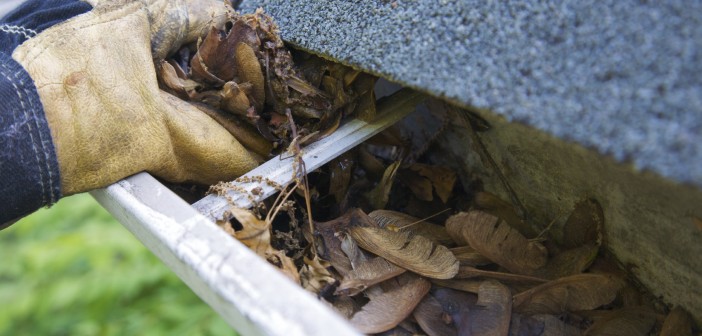Rain gutters (eaves troughs if you are Canadian) and downspouts are common around the world, both in wet and dry regions. In the wet climates, they keep water away from the foundation of the building, and in dry climates, they collect valuable water for irrigation or household use. But gutters collect more than water. They also collect leaves, dirt, debris, small twigs and tree branches, and that baseball you have been seeking for the last three years. Clogged up gutters develop a sort of a “swamp soup” that is unpleasant to the eyes as well as to the nose. Regular and emergency gutter clean out is necessary, not only to avoid the bad aesthetics and the stench of malfunctioning gutter troughs and spouts, but also to avoid the damage and expenses that can be incurred if they are left to clog unchecked.
The Way a Gutter is Supposed to Work
Gutters are attached to the roof underneath the shingles and paper to prevent leaking. They are cut slightly past the edges of the roof to ensure no water sneaks by on one side or the other. Their seams are to be caulked with specialized gutter sealant that is highly durable and water proof. Rain falls on the roof, gravity takes it to the gutters, the proper incline of the gutter moves the water to a downspout connection, and the water then goes down the spout and out an extender to a safe distance from the house’s foundation. Alternatively, the downspouts may feed into a rain barrel that then irrigates your garden or gives you a shower water source. That is how gutters are designed to function.
Gutter that are Not Working
Like everything man-made, problems and deterioration eventually set in. Seams can leak. Seamless gutters have no seams except at the corner pieces, but it is possible for the corners to leak too. Wind, rain, and debris may strain the gutter and cause it to break loose from its brackets and galvanized gutter screws and sag or even hang there dangling in the air. Some non-aluminum types may rust if the paint wears off, or else become permanently stained. Gutters can also get badly dented, or if filled with water, lean forward and spill water over the edge. In such cases, the gutter pieces in question may need to be replaced or repaired. Clogged spouts or troughs, however, are the most common problem, and they will need to be cleaned out. Gutter guards can greatly reduce the need for gutter cleaning, but still eventually it will be a good idea to get some gloves, a bucket, and a hose and go to work. Otherwise, if you don’t like ladder work nor own ladders, you may need to pay the neighborhood kid or a professional gutter company to do it for you.
Damage Clogged Gutters Can Cause
Besides the damage to the gutters themselves, clogged gutters cause many other problems. Mosquitos, ants, and termites will be attracted to the standing water. Leakage can damage the edge of the roof and find its way into the house to do additional damage. The de-facto lack of a gutter will allow all that the gutter was meant to prevent to occur. The foundation, basement, and crawlspace can take punishment as can a deck that lies just under the gutter. Ice dams can make things more dangerous in the winter. The fascia board may be rotted from a leaky gutter, and your beautiful landscaping soil may erode away, while the plants and flowers get pounded down by falling gutter water. All this on top of your reputation sinking with your neighbors who see the Hanging Gardens of Babylon growing in your gutters.
Gutter Clean Up and Maintenance
All leaves and debris will need to be removed from the troughs by hand or with a small gardening tool and thrown in a bucket or garbage can. The downspouts may need to be taken off to be cleaned if they are badly clogged. If only a little clogged, you can run the hose water through the spouts.
We talked with Metroplex Window & Gutter Cleaning who said, “Before you consider the job complete, fill the gutters with water and watch to see if it goes where it is supposed to go and at a decent speed. It will be a good idea to have tree branches that overhang the roof cut back to prevent heavy gutter gunk build up in the future. Any leaks will need to be caulked, and any sagging areas supplied with brackets and screws. Some jobs may require professional help.”




